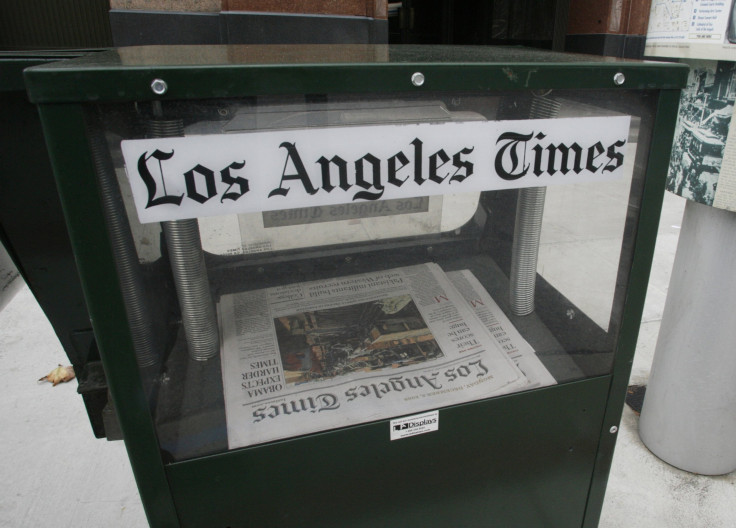How Much Is The Los Angeles Times Really Worth? Sale Rumors Swirl Amid Tribune Publishing Financial Woes

Anyone who followed its recent flood-the-zone coverage of the San Bernardino, California, shooting could see the value of the Los Angeles Times as a newsgathering machine. But with the paper’s financial future hanging in the balance after another round of staff cuts, rumors of its impending sale continue to swirl in media circles, raising the key question of what the 134-year-old paper is actually worth. And for Tribune Publishing, the paper’s troubled parent company, the clock is ticking.
“The longer you wait, the cheaper it gets,” said Gabriel Kahn, a professor at the University of Southern California’s Annenberg School of Communication and Journalism who follows the economics of the newspaper industry.
Whatever the price settles at, it won’t be anywhere near what it was in the paper’s heyday. Chicago’s Tribune Co. bought the L.A. Times’ then-parent company, Times Mirror Co., for $8.3 billion in 2000, back before Craigslist completely undid the classifieds industry, when people actually bought and sold stuff through printed ads. At the time, the L.A. Times had more than 1,000 staffers, a paid circulation north of 1 million and 20-plus foreign bureaus.
Before the latest buyout, those numbers had dwindled down to about 500, less than 400,000 and six, respectively.
And even those dwindling stats won’t come cheap. Tribune Publishing, which owns the Times and a handful of other newspapers, has a market cap of about $250 million and about $400 million in long-term debt, meaning it’s almost certainly going to take at least $650 million to acquire the entire company. Still, one investment banker, who requested anonymity because he’s worked with several likely bidders, said a stand-alone California News Group -- made up of the Times and the San Diego Union-Tribune -- should command at least $200 million by itself. He added that he expects the company to be under new, local ownership by this time next year.
That estimate falls short of the $250 million that Amazon founder Jeff Bezos paid for the Washington Post in 2013. But a $200 million price tag would effectively value Tribune Publishing’s other assets, including the Chicago Tribune and Orlando Sentinel newspapers, at just $50 million -- or about one-thirtieth of the value of BuzzFeed.
Small Circle
Kahn said that as a newspaper company with shrinking revenue, the potential pool of bidders for the California papers -- if they could be pried away from Tribune Publishing -- is tiny.
“At best, there could be two motivated buyers here,” he said.
Some insiders say Eli Broad, a philanthropist who’s active in myriad local causes and has bid on the paper before, is the heavy favorite, but his motivation likely has its limits.
As part of last year’s spinoff, Tribune kept its profitable TV stations and real estate as part of a renamed Tribune Media Co. Tribune Publishing, meanwhile, was saddled with $350 million in debt, and has been bleeding money since, with its flagging stock price sparking rumors of a sale. But in September, the company put out a press release basically telling suitors -- namely Broad, who had made an offer around that time -- to stop trying to pry away the California assets.
A Hostile Takeover?
As the California News Group papers are estimated to make up about 40 percent of Tribune Publishing’s revenue -- and give it a true national reach -- it’s not surprising Tribune Publishing doesn’t want to sell them. Tribune Publishing’s ownership structure makes it possible that the entire company could be acquired in a hostile takeover if a truly motivated buyer wants to gain control of the Times that way, but that person or group has yet to emerge. And if Broad or a similar civic-minded L.A. buyer decides to acquire all of Tribune Publishing, it’s likely he’d try to recoup some money by selling off some of the other papers.
Matthew Brooks, an analyst who covers Tribune Publishing for Macquarie, doesn’t see a lot of financial upside in the whole company barring a successful big bet on digital media.
“Generally, I think whoever buys Tribune Publishing will be disappointed, unless they invest a lot on digital and it works,” he told International Business Times in an email.
And even if they were to invest heavily in digital, the new owners couldn’t capitalize on selling off the L.A. Times' property, as has been the case with some other recent newspaper deals. That's because Tribune Publishing no longer owns the Times’ Spring Street headquarters or any of its other real estate. Late last month, Tribune Media hired a broker to explore the sale of 25 acres in downtown L.A.'s Arts District that contains the Times' printing press, where some property values have nearly tripled in a year. It’s hard to predict a sale price for that piece of property -- but a two-acre paved lot on nearby Bay Street sold for $11.5 million in April, and as investors from around the world pour money into L.A. real estate, the market for that site has only become more frenzied.
The same can't be said for the paper that prints there.
© Copyright IBTimes 2025. All rights reserved.





















